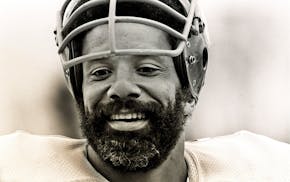Logan Swensen has heard the stories and has a hard time believing them.
"I think what they were doing was torture," Swensen said.
What they were doing was cutting weight, a wrestling strategy of losing pounds in an attempt to drop to a lower weight class and gain a competitive advantage.
Swensen is a senior wrestler for Wayzata who is ranked No. 1 in the 133-pound class. Swensen's father, Eric, is Wayzata's head wrestling coach, and he's told Logan about the haphazard, unhealthy methods of losing weight that are prominent in the history of wrestling. Often it required starvation, dehydration and sweat-soaked workouts in overheated rooms. Cutting weight was an exercise in perseverance and pain. The hope was that it would be the difference between winning and losing.
More often, it just made wrestlers weaker.
"We didn't know what we were doing," said Eric Swensen, who wrestled in high school in Connecticut and in college in Massachusetts. "When [assistant coach and Minnesota Hall of Famer] Dave Droegemueller and I start telling stories about cutting weight, they're the same stories. We were all doing it wrong. We thought it was right because it was the only way we knew how to lose weight, but it was wrong because it was not healthy. I was spitting in a cup. Why should I need to spit in a cup?"
Cutting weight was long a practice, and it long raised concerns. Until about 10 years ago, virtually all wrestlers could relate a horror story or two about enduring the process.
“We want to end these negative stereotypes and make sure kids develop a healthy lifestyle and have fun in the sport.”
No longer. The Star Tribune asked coaches across the metro about their approach to cutting weight. Nine responded in detail, saying now there's greater scrutiny, with stronger safeguards and an emphasis on healthy lifestyle practices that can carry over off the mat. While weight always will be tied inextricably to wrestling for the purpose of competitive classification, the coaches said the approach most wrestlers take now is based on healthy nutrition and sound weight management practices.
Suffering to reduce weight has gone the way of the full nelson.
Strength, not weight
"Most kids do not 'cut weight' like we once did," New Prague coach Dan Wagner said in an email to the Star Tribune. "We promote a healthy lifestyle and letting your body do what it needs to do. Rather than 'cutting weight,' we promote management."
Woodbury coach Justin Smith is also chair of the Health/Physical Education Department at the high school. He stresses the identification of goals and how to reach them.
"We tell our wrestlers that their focus is that they should look to be the strongest wrestler in their weight class," Smith said. "That does not happen if they are trying to unhealthily lose a bunch of weight."
As long as weight limits are necessary, there will be occasions when wrestlers will need to drop a few pounds to reach the desired weight. It doesn't have to be exact. A 2-pound allowance for high school matches took effect after the first of the year.
But if the discrepancy between the actual weight and desired weight is greater than that, the issue gets trickier. Many coaches strongly encourage a diet that limits, or eliminates altogether, foods that don't promote healthy habits. Food isn't restricted, because staying properly nourished is vital, but the emphasis is on proteins over fats, the timely addition of complex carbohydrates and more than enough water. The latter is opposite of what was once believed. Water deprivation long was seen as a quick route to weight loss.
"I drink about a gallon of water a day," Logan Swensen said. "… It's kind of funny that you lose more weight by drinking more, not less."
And instead of ordering sweat-drenched workouts in rubber shirts, coaches stress that, with the proper nutrition and knowledge, weight loss occurs naturally during practices.
"A majority of athletes lose weight during the season, mainly because of the work they are putting in on a daily basis as well as often they change their diet to help fuel their bodies correctly," Waconia coach Nicholas Hackman said.
Smith sided with that.
"We tell parents the physical exertion needed during the course of the season is like no other," he said. "Their bodies will naturally lose excess fat during the season if their eating habits … are on the same level of what is recommended. This may result in a natural drop of a weight class over the course of a season."
Careful decisions
Coaches agree that there are times when deliberate weight loss is necessary. Perhaps a team has two viable wrestlers at one weight. Or a wrestler feels he has a better chance at success at a lower weight. Guidelines are in place to make sure it's done thoughtfully and safely. Wrestlers undergo a weight certification test, a skin-fold assessment to determine their body-fat percentage. The leaner the athlete, the less likely he or she will try to lose weight. If a wrestler chooses to drop weight, it becomes a discussion with the coach, who then determines whether there is a compelling reason.
Wagner said most coaches believe cutting weight can be done safely "if done the right way … managing a healthy diet, exercise, rest and gradually losing body fat to get to a more fit weight."
A history of slapdash weight loss techniques still casts a shadow over wrestling. But as change becomes norm, coaches say the sport is in a better place now than it was a generation ago.
"Wrestling is a great sport that prepares you for life," Eric Swensen said. "We want to end these negative stereotypes and make sure kids develop a healthy lifestyle and have fun in the sport."
A $2.8 billion settlement will change college sports forever. Here's how

Reusse: Country boy Jim Marshall never lost his lust for life

Twins open homestand with loss to Blue Jays, Jeffers ejected after critical call

Vikings GM talks to the Star Tribune about the team's 2025 outlook, McCarthy's trajectory


